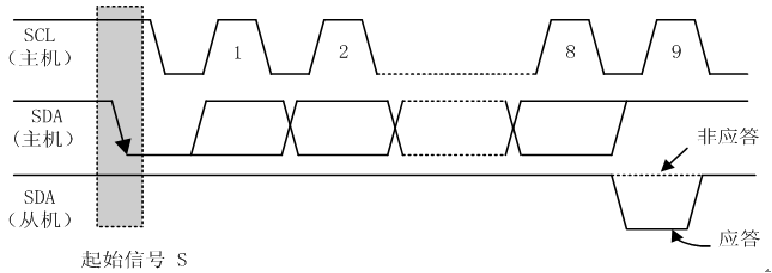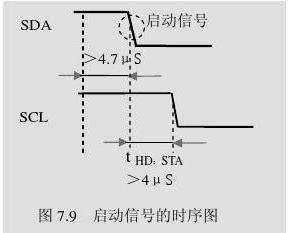发送启动信号S
在同步时钟线SCL 为高电平时,数据线出现的由高到低的下降沿。 启动信号子程序STA
1 /*******************************************************************************
2 * 函数名 : I2cStart()
3 * 函数功能 : 起始信号:在SCL时钟信号在高电平期间SDA信号产生一个下降沿
4 * 输入 : 无
5 * 输出 : 无
6 * 备注 : 起始之后SDA和SCL都为0
7 *******************************************************************************/
8
9 void I2cStart()
10 {
11 SDA=1;
12 Delay10us();
13 SCL=1;
14 Delay10us();//建立时间是SDA保持时间>4.7us
15 SDA=0;
16 Delay10us();//保持时间是>4us
17 SCL=0;
18 Delay10us();
19 }
发送停止信号P
在SCL 为高电平期间SDA 发生正跳变。
停止信号子程序STOP

1 /*******************************************************************************
2 * 函数名 : I2cStop()
3 * 函数功能 : 终止信号:在SCL时钟信号高电平期间SDA信号产生一个上升沿
4 * 输入 : 无
5 * 输出 : 无
6 * 备注 : 结束之后保持SDA和SCL都为1;表示总线空闲
7 *******************************************************************************/
8
9 void I2cStop()
10 {
11 SDA=0;
12 Delay10us();
13 SCL=1;
14 Delay10us();//建立时间大于4.7us
15 SDA=1;
16 Delay10us();
17 }
等待应答信号
应答信号:应答信号由接受设备产生,在scl信号为高电平期间,接受设备将SDA拉低为低电平一段时间,表示数据传输正确。

非应答信号:应答信号由接受设备产生,在SCL信号为高电平期间,接受设备不将将SDA拉低为低电平一段时间,没有应答。
1 /*******************************************************************************
2 * 函数名 : yingda()
3 * 函数功能 : 对数据是否被从机接受给出应答/非应答信号(1/0)
4 * 输入 : 无
5 * 输出 : 0或1。发送成功返回1,发送失败返回0
6 * 备注 : 发送完一个字节SCL=0,SDA=1
7 *******************************************************************************/
8 void yingda()
9 {
10 unsigned char b;
11 while(SDA)//等待应答,也就是等待从设备把SDA拉低
12 {
13 b++;
14 if(b>200) //如果超过2000us没有应答发送失败,或者为非应答,表示接收结束
15 {
16 SCL=0;
17 Delay10us();
18 return 0;
19 }
20 }
21 SCL=0;
22 Delay10us();
23 return 1;
24 }
通过I2C发送一个字节
数据传送格式

unsigned char I2cSendByte(unsigned char dat)
{
unsigned char a=0;//最大255,一个机器周期为1us,最大延时255us。
for(a=0;a<8;a++)//要发送8位,从最高位开始
{
SDA=dat>>7; //起始信号之后SCL=0,所以可以直接改变SDA信号
dat=dat<<1;
Delay10us();
SCL=1;
Delay10us();//建立时间>4.7us
SCL=0;
Delay10us();//时间大于4us
}
SDA=1;
Delay10us();
SCL=1;
yingda(); //应答子函数
}
使用I2c读取一个字节
1 /*******************************************************************************
2 * 函数名 : I2cReadByte()
3 * 函数功能 : 使用I2c读取一个字节
4 * 输入 : 无
5 * 输出 : dat
6 * 备注 : 接收完一个字节SCL=0,SDA=1.
7 *******************************************************************************/
8
9 unsigned char I2cReadByte()
10 {
11 unsigned char a=0,dat=0;
12 SDA=1; //起始和发送一个字节之后SCL都是0
13 Delay10us();
14 for(a=0;a<8;a++)//接收8个字节
15 {
16 SCL=1;
17 Delay10us();
18 dat<<=1;
19 dat|=SDA;
20 Delay10us();
21 SCL=0;
22 Delay10us();
23 }
24 return dat;
25 }
以At24c02举例说明i2c总线读写数据过程
a、主机向从机发送数据,数据传送方向在整个传送过程中不变:

注:有阴影部分表示数据由主机向从机传送,无阴影部分则表示数据由从机向主机传送。
A表示应答, A非表示非应答(高电平)。
S表示起始信号,P表示终止信号。
1 /*******************************************************************************
2 * 函数名 : void At24c02Write(unsigned char addr,unsigned char dat)
3 * 函数功能 : 往24c02的一个地址写入一个数据
4 * 输入 : 无
5 * 输出 : 无
6 *******************************************************************************/
7
8 void At24c02Write(unsigned char addr,unsigned char dat)
9 {
10 I2cStart();
11 I2cSendByte(0xa0); //发送写器件地址 用“0”表示主机发送数据(T),“1”表示主机接收数据(R)
12 I2cSendByte(addr);//发送要写入内存地址 13 I2cSendByte(dat); //发送数据14 I2cStop(); 15 }
b、主机从从机读数据

1 /*******************************************************************************
2 * 函数名 : unsigned char At24c02Read(unsigned char addr)
3 * 函数功能 : 读取24c02的一个地址的一个数据
4 * 输入 : 无
5 * 输出 : 无
6 *******************************************************************************/
7
8 unsigned char At24c02Read(unsigned char addr)
9 {
10 unsigned char num;
11 I2cStart();
12 I2cSendByte(0xa0); //发送写器件地址
13 I2cSendByte(addr); //发送要读取的地址
14 I2cStart();
15 I2cSendByte(0xa1); //发送读器件地址
16 num=I2cReadByte(); //读取数据
17 I2cStop();
18 return num;
19 }
来源:https://www.cnblogs.com/zhj868/p/12536778.html
